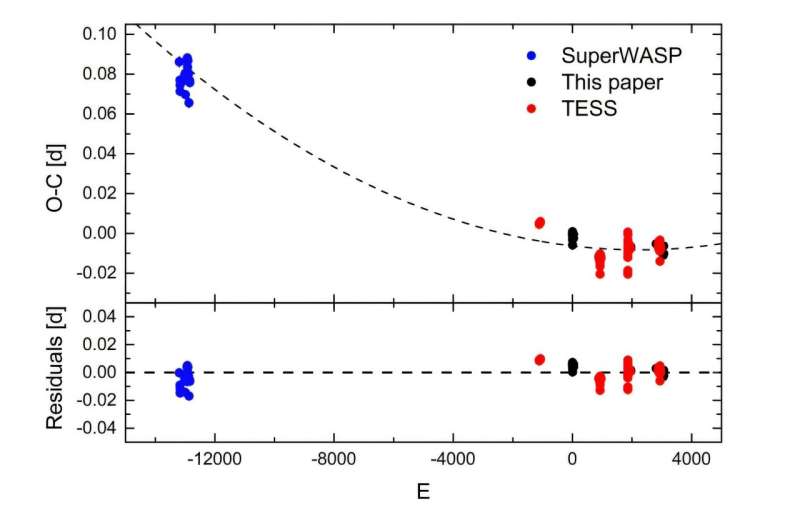Astronomers from China and South Korea report the detection of a contact binary system with an extremely low mass ratio of only 0.0356. The newfound system, which received the designation TYC 3801-1529-1, is therefore the lowest mass ratio contact binary discovered to date. The finding was detailed in a paper published November 19 on the preprint server arXiv.
Contact binaries consist of two stars orbiting so closely that they share a common gaseous envelope. The components of such systems often have similar effective temperatures and luminosities, regardless of their respective masses.
The cutoff mass ratio for contact binaries is still a subject of debate. Latest studies suggest that these binaries should have a minimum mass ratio of about 0.038-0.041.
TYC 3801-1529-1 was first classified as a contact binary in 2020. The system is located at an estimated distance of 1,260 light years and its orbital period is approximately 0.366 days. Although very little is known about the properties of TYC 3801-1529-1, previous studies have suggested that it may be an extremely low-mass-ratio contact binary.
Recently, a team of astronomers, led by Kai Li of Shandong University in China, have employed the Weihai and Xinlong observatories to perform photometric and spectroscopic observations of TYC 3801-1529-1. The observational campaign, complemented by data from NASA’s Transiting Exoplanet Survey Satellite (TESS), resulted in the first comprehensive investigation of this binary.
“This paper presents the first analysis of the contact binary TYC 3801-1529-1. We observed four sets of multiple bands complete light curves and one set of radial velocity curves of the primary component,” the researchers wrote.
The observations found that the primary star in TYC 3801-1529-1 has a mass of about 2.096 solar masses, while its companion has a mass of only 0.075 solar masses. This yields a mass ratio at a level of 0.0356, which is the lowest value for any known contact binary. The radii of the primary and secondary stars were measured to be 1.93 and 0.43 solar radii, respectively.
Based on the new results, the authors of the paper classified TYC 3801-1529-1 as an A-type W UMa contact binary with a contact degree of approximately 35.7%. The photometric distance to TYC 3801-1529-1 was calculated to be about 2,035 light years. Therefore, the system turned out to be located much further away than previously thought.
Analyzing the light curves of TYC 3801-1529-1 from 2022, the astronomers found that they are asymmetric. This could be explained by a hot spot on the primary star.
Summing up the results, the scientists emphasized that the extremely low mass ratio of TYC 3801-1529-1 poses a challenge to theoretical research. Thus, it is expected that the two components will undergo a merger.
“Future observations should be carried out to continuously monitor this system in order to observe its merging process,” the astronomers concluded.
More information:
Kai Li et al, Detection of the lowest mass ratio contact binary in the universe: TYC 3801-1529-1, arXiv (2024). DOI: 10.48550/arxiv.2411.12132
Journal information:
arXiv
© 2024 Science X Network
Citation:
Observations detect the lowest mass ratio contact binary to date (2024, November 26)
retrieved 26 November 2024
from https://phys.org/news/2024-11-lowest-mass-ratio-contact-binary.html
This document is subject to copyright. Apart from any fair dealing for the purpose of private study or research, no
part may be reproduced without the written permission. The content is provided for information purposes only.

